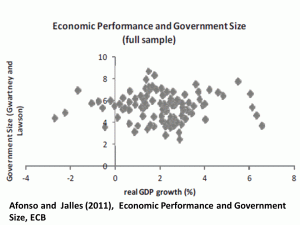Last week, ‘two lads from the ECB’ contributed to the debate on the state of the economy. They were cited by the venture capitalist, Jon Moulton, on Newsnight, as providing evidence that Governments harm growth. It was contribution which showed the shallowness of much of the debate on the economy.
The two lads
The two lads from the ECB came up during a Newsnight debate on the Budget on 19 March – you can watch it here.
As shown in the images (from Mohammed Tanweer) Moulton stated: ‘the bigger the public sector the less likely you are to have growth. It is a pretty well established relationship.’
Mariana Mazzucato (Professor, University of Sussex) responded in the appropriate scholarly fashion: ‘by whom?’
Moulton: ‘Well…umm… A couple of lads at the ECB. A couple of lads at Stockholm. I can send you the graphs.’
Who are these likely lads?
The couple of lads from ECB are António Afonso and João Tovar Jalles who published a paper on ‘Economic Performance and Government Size’ in 2011 (thanks to Romesh Vaitilingam for pointing this out). According to Afonso and Jalles: ‘Our results show a significant negative effect of the size of government on growth’. Although they also argue: ‘economic progress is limited when government is zero percent of the economy’. Quite! I wonder where and when they had in mind?
So what do the graphs show that Moulton has now probably sent to Professor Mazzucato? They are shown below; and you would need a distorted and perverse perspective to imagine that they show that government harms growth. But we do not need to believe our eyes as we can turn to art of modern economics.
The art of modern economics
The economics of the ECB lads is apparently impressive: they have a model with the required algebra and lots of numbers supported by sophisticated statistics. But, as with much modern economics, when you scratch beneath the surface, you find assertions supported by some correlations. And be careful when you see the term ‘significant’ bandied about – this refers to ‘statistical significance’ which tells us nothing about economic significance or the size of any apparent effects.
Yada Yada Economics
As with most economics papers, Afonso and Jalles have an economic model: ‘a typical economy with a constant elasticity of substitution utility function of the representative agent…….’ blah, blah, blah, lots of algebra etc. This looks scientific although many readers will not read it or will not understand it. But the model is superfluous. The construct of ‘a model’ is an artificial edifice now required in most modern economics as its physics-envy knows no bounds. The authors’ arguments are based on correlations between some variables, but you can construct many different ‘models’ and still end up performing the same correlations.
The evidence
The evidence of the lads is a series of multiple correlations – wrapped up with a battery of statistical ‘tests’ and ‘robustness checks’. But what this amounts to is that if you massage the data enough you can show that economic growth is inversely correlated with the size of Government (as a share of the economy). Correlations say nothing about causation – causation is imposed by the authors. Some economists believe that they can prove causality through a statistical test – such as the Granger Causality test – this technique can be used to show that consumers expenditure in early December caused Christmas later in the month.
Afonso and Jalles argue that their correlations show that if government increases (as a share of GDP) then economic growth falls. But they fail to consider more plausible explanations for this. First, causality may run the other way: if growth of the economy falls for other reasons then the share of Government in GDP will increase as the denominator (GDP) is smaller – and more so, if the Government makes transfer payments to the unemployed which increases the numerator. Second, rich countries tend to grow slower than poorer countries (that can have catch-up growth); and as economies become richer, Government as a share of GDP tends to increase as Governments often supply goods and services that prosperous consumers want – such as education and health. Since 1960, the size of Government (as a share of GDP) has increased in every OECD country.
Debataing the Dismal Economy
The economic crisis has led to much debate about economic policy. And much has been highly informative – for example, see the debate between Wolf and Giles in the FT, and the contributions by Faisal Islam, Jonathan Portes, David Smith and Simon Wren-Lewis.
But much of the discussion has frequently been vapid and vacuous. With often confusion between: when and how to reduce the deficit; and the role and size of Government. And the use of economic ‘evidence’ has often been uncritical and instrumental – including so-called ‘well established relationships’.
Decisions about economic policy and the role of the state are inherently political and should be driven by what sort of society people want to live in – and they should not hide behind the false veil of the pseudo-scientific objectivity of modern economics.





He also referred two “a couple of lads from Stockholm”, probably meaning this http://journalistsresource.org/wp-content/uploads/2011/08/Govt-Size-and-Growth.pdf
But the lads from Stockholm say “The negative correlation has yet to be reconciled with the fact that big government is clearly correlated with higher levels of affluence” and “we discuss two explanations of why several countries with high taxes seem able to enjoy above average growth: (i) that countries with higher social trust levels are able to develop larger government sectors without harming the economy, and (ii) that countries with large governments compensate for high taxes and spending by implementing market-friendly policies in other areas. Both explanations are supported by current research.”
Not really uncompromising support for huge reductions in the size of the state……